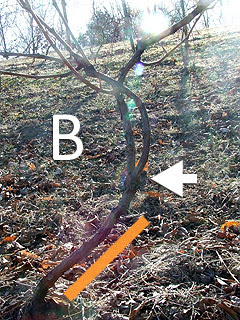 I talked last week about double-trunking. I should make a few additional points on this topic while it's pruning season. You shouldn't wait for freeze, diesease or mechanical damage to replace a trunk. You should consider keeping trunks of various ages; one older trunk and one young trunk is the best combination in our climate region. A younger trunk means fewer years of freezing, splitting, cracking and scraping. Even on healthy vines you should build a replacement plan into the pruning schedule every few years, if not more frequently. I've included another photo of a GDC trained Norton vine. Last year I allowed several suckers to grow up on this vine even though both cordons are healthy and productive. One of these new suckers looks like it will be a viable trunk (highlighted in yellow), so that I'll be able to prune off one of the old cordons (pink) and wind up with trunks of two different ages. The replacement trunk will also be straighter and correct the problem of the split of trunks being too high on the vine, which we talked about last week.
I talked last week about double-trunking. I should make a few additional points on this topic while it's pruning season. You shouldn't wait for freeze, diesease or mechanical damage to replace a trunk. You should consider keeping trunks of various ages; one older trunk and one young trunk is the best combination in our climate region. A younger trunk means fewer years of freezing, splitting, cracking and scraping. Even on healthy vines you should build a replacement plan into the pruning schedule every few years, if not more frequently. I've included another photo of a GDC trained Norton vine. Last year I allowed several suckers to grow up on this vine even though both cordons are healthy and productive. One of these new suckers looks like it will be a viable trunk (highlighted in yellow), so that I'll be able to prune off one of the old cordons (pink) and wind up with trunks of two different ages. The replacement trunk will also be straighter and correct the problem of the split of trunks being too high on the vine, which we talked about last week.One other tidbit of information this week. As the wind chill dropped down to minus twelve degrees this week (and yes, we did have days of 70+ weather and tornados not three weeks ago), I started to worry about vine death. A friend pointed out though that vines don't experience wind chill because they have no mosture as a result of going into dormancy. That's a relief, as wind chill is often ten or even twenty degrees lower than acutal temperature.






